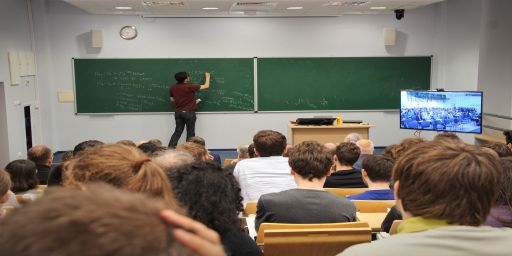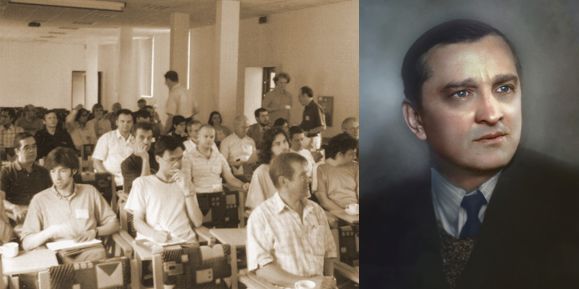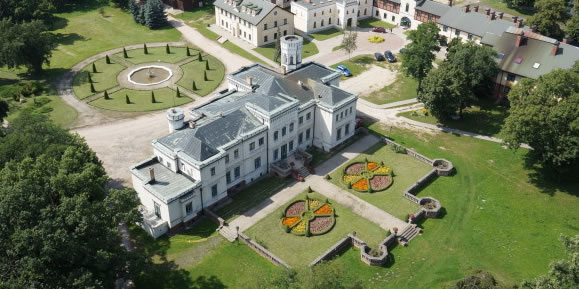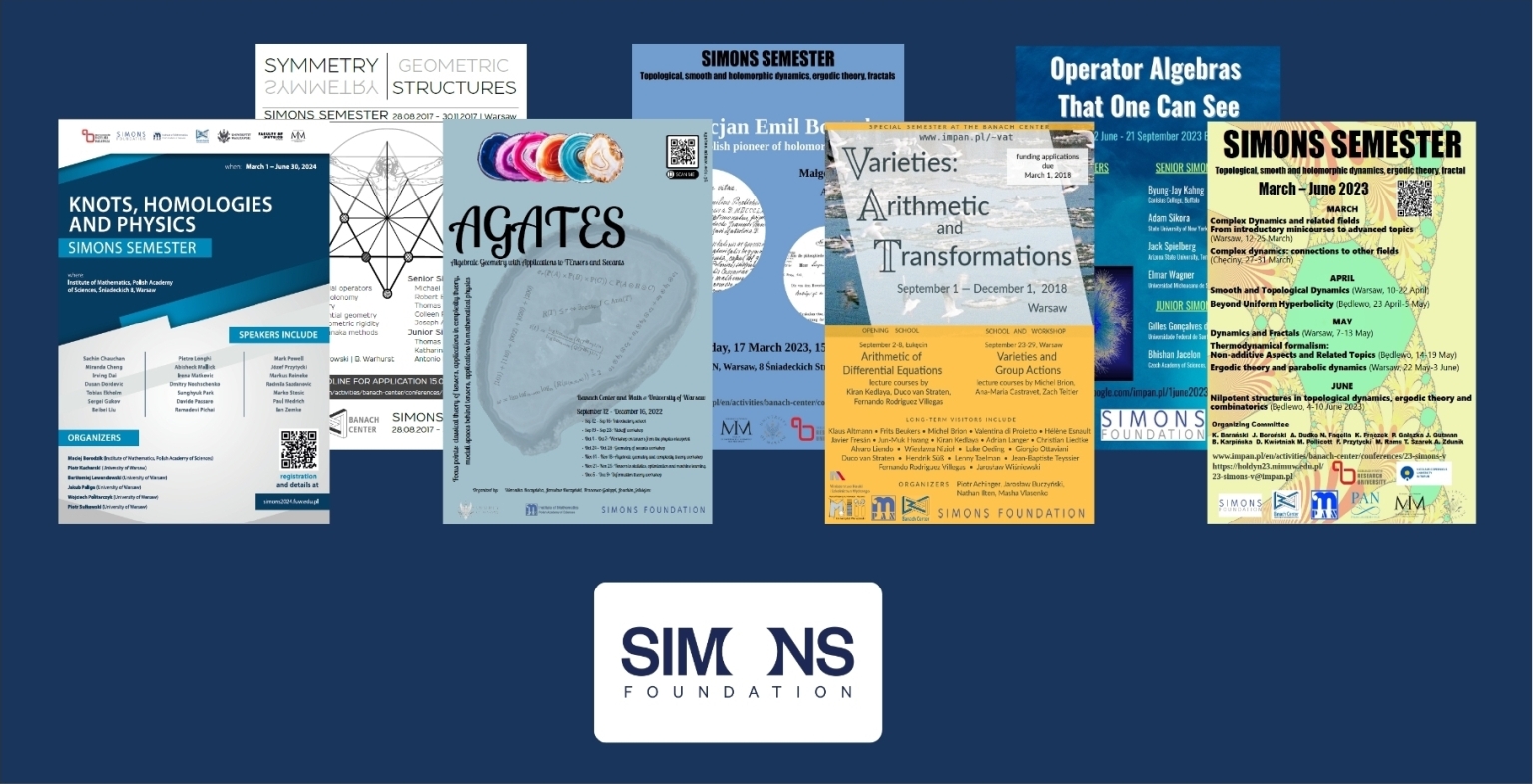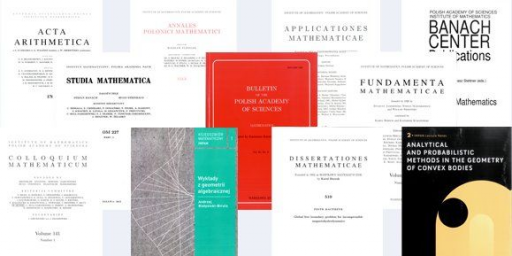Variational methods and PDEs
Organizers: dr Bartosz Bieganowski, dr Michał Łasica, dr hab. Jarosław Mederski
Monday, room no. 1, 10:15 - 12:00.-
October 7, 2024
Andrzej Szulkin (Stockholm University): A Schrödinger system with shrinking regions of attraction.
Abstract: We consider an elliptic system of equations whose solutions describe some kind of species or particles. The species of the same kind are attracted to a small region which shrinks to a point and different species repel each other. We formulate existence results, limit profiles and concentration. We also present details of some proofs. -
September 16, 2024
Norihisa Ikoma (Keio University): A Lagrangian function approach to the L^2-normalized problem with potentialAbstract: For the L^2-normalized problem with the L^2-subcritical growth, a standard method is to solve the minimizing problemof the energy functional on the L^2-sphere. On the other hand, the L^2-normalized problem is equivalent to finding critical points of the functional under a constraint and hence a Lagrangian function may be useful. This approach was developed by Hirata and Tanaka (’19) in the L^2-subcritical case without potential functions. In this talk, I will talk about this approach for the L2-normalized problem which contains a potential function. This is based on joint work with Mizuki Yamanobe. -
May 6, 2024
Łukasz Chomienia (MIM UW): Regularity of solutions to elliptic PDEs on low-dimensional structuresAbstract: The talk is mainly devoted to elliptic-type problems considered within the setting of "thin" subsets of Euclidean space, the so-called
low-dimensional structures. We focus on various regularity aspects of weak solutions. Using certain geometric extensions of functions supported on "thin" structures, we obtain higher Sobolev regularity on each component manifold of the low-dimensional structure. This regularity type is insufficient as it does not capture any connection
between higher-order behaviour on various parts of the structure. We upgrade it to obtain membership of weak solutions in the domain of the low-dimensional second-order operator. To this end, we show that for a solution to the elliptic problem, a certain normal to the low-dimensional structure vector field exists that regularizes the
structure-related gradient. Relying on previous results, we derive the global continuity of weak solutions. Based on https://arxiv.org/abs/2311.16280 -
April 29, 2024
Marco Squassina (Catholic University of the Sacred Heart in Brescia): Overview and new results on concavity of positive solutions for elliptic PDEs
Abstract: We overview the problem of investigating concavity (up to a smooth transformation) of positive solutions to some classes of nonlinear elliptic PDEs. We also present new results in various directions. This is based on joint works with William Borrelli , Claudia Bucur, Marco Gallo, Sunra Mosconi. -
March 18, 2024
Jacopo Schino (MIM UW): About solutions with prescribed norm to a Schrödinger equation in a mixed regime
Abstract: I will present a multiplicity result about the existence of solutions to an elliptic Schrödinger equation, coupled with an L²-constraint, and the dynamics of the corresponding stationary waves. Here, the behaviour of the non-linear term is mass-subcritical at the origin and mass-supercritical at infinity. Remarkably, the first solution's existence and dynamical properties occur in a very general framework, which is not the case for the second solution.This is joint work in progress with Bartosz Bieganowski and Pietro d'Avenia. -
March 11, 2024
Jacek Jendrej (CNRS, Université Sorbonne Paris Nord): Dynamics of multi-solitons for Klein-Gordon equations
Abstract: We consider the Klein-Gordon equation in dimension 1+3 with the focusing cubic nonlinearity. The model admits nontrivial positive static solutions (ground states), which yield traveling waves (solitons) via the Lorentz transform. We consider multi-solitons, which are defined as superpositions of solitons separated by large distances and having distinct velocities. Our first result is the asymptotic stability of the multi-solitons, namely we prove that if a solution stays close to the multi-soliton family for all time, then it converges to a superposition of solitons and a radiation term solving the linear Klein-Gordon equation. In our second result, we classify all the pure multi-solitons, that is solutions as above for which the radiation term has zero energy. Our results can be interpreted as a construction of (center-)stable manifolds of the multi-soliton family.
This is a joint work with Gong Chen from the Georgia Institute of Technology. -
March 4, 2024, 12:15!
Michał Miśkiewicz (MIM UW): Perspectives on the p-harmonic map flow
Abstract: The p-harmonic map flow is a flow of maps u : M → N between two given manifolds, and it is designed to decrease the Dirichlet p-energy (i.e. the integral of the gradient raised to the p-th power) in time. It is useful in studying p-harmonic maps, which are simply its stationary solutions. Since the pioneering work of Eells-Sampson ('64) and Chen-Struwe ('89), much is known about the special case p=2, but the general case is still full of open questions. In addition to difficulties related to the p-Laplace operator, a major obstacle seems to be the lack of a local energy monotonicity formula (due to Struwe in the case p=2). I will describe a new, alternative formulation of the p-harmonic map flow, based on the homogeneous (a.k.a. game-theoretic) p-Laplace operator. This homogeneous formulation indeed implies a Struwe-type monotonicity formula, but it comes with new fundamental challenges.The talk is based on joint work with Erik Hupp (arXiv:2308.16096). -
January 15, 2024, 14:00
Remy Rodiac (MIM UW): Large systems of interacting points at equilibrium in the plane
Abstract: In this talk I will consider equilibrium solutions of a system of ODEs describing N points interacting via a Coulomb potential in the plane. When N is large we expect the limit of the empirical measure of the positions of the points to satisfy a system of PDEs. I will describe the difficulties to understand the limit N goes to infinity (transform the equilibrium relations into a non-linear PDE and pass to the limit in this PDE) and explain how we can solve them to obtain the result. -
November 6, 2023
Justyna Ogorzały (Wojskowa Akademia Techniczna): A system of quasi-variational-hemivariational inequalities with application to contact mechanics
Abstract: We will present a general class of systems of strongly coupled quasi-variational–hemivariational inequalities with implicit constraints in reflexive Banach space and we will show that such systems have a solution. The result generalizes several theorems on various particular cases on variational, variational–hemivariational, and quasi-variational inequalities. Next, we will use abstract result to study a static thermoelastic frictional contact. -
October 23, 2023
Daniel Strzelecki (Nicolaus Copernicus University): Equivariant Conley index and Hamiltonian systems
Abstract: We are going to sketch the construction of the equivariant Conley index (defined by Izydorek). Then we show how to utilize this tool in the study of periodic solutions of Hamiltonian systems. As an example the draft of the proof of symmetric Lyapunov center theorem will be shown. -
October 16, 2023
Laura Baldelli (IM PAN): Existence results for nonlinear elliptic equations with degenerate coercivity via blow-up
-
September 4, 2023
Bartosz Bieganowski (University of Warsaw): Working seminar on travelling waves
-
March 30, 2023
Roberta Filippucci (Università degli Studi di Perugia): Existence and nonexistence of positive radial solutions of a quasilinear Dirichlet problem with diffusion
Abstract: We consider a $m$-Laplacian Dirichlet problem on a ball of $\mathbb R^N$ with a diffusion term, inside the divergence, depending on the solution, and we discuss existence and nonexistence of radial positive solutions. In particular, we obtain a new critical exponent, which extends the one relative to the case with no diffusion and it divides existence from nonexistence of positive radial solutions. The results are obtained via several tools such as a suitable modification of the celebrated blow-up technique, Liouville type theorems, a fixed point theorem and a Pohožaev-Pucci-Serrin type identity. This is a joint work with Laura Baldelli and Valentina Brizi. -
March 13, 2023
Jacek Jendej (CNRS, Université Sorbonne Paris Nord): Dynamics of kink clusters for scalar fields in dimension 1+1
Abstract: We consider classical scalar fields in dimension 1+1 with a
self-interaction potential being a symmetric double-well. Such a model
admits non-trivial static solutions called kinks and antikinks. A kink
cluster is a solution approaching, for large positive times, a
superposition of alternating kinks and antikinks whose velocities
converge to 0 and mutual distances grow to infinity. Our main result is
a determination of the asymptotic behaviour of any kink cluster at the
leading order.
Our results are partially inspired by the notion of "parabolic motions"
in the Newtonian n-body problem. I will present this analogy and mention
its limitations. If time allows, I will explain the role of kink
clusters as universal profiles for formation of multi-kink configurations.
This is a joint work with Andrew Lawrie from MIT. -
March 6, 2023
Adam Konysz (UMK): Working seminar on semiclassical states for the curl-curl problem -
February 6, 2023
Laura Baldelli (IMPAN): Working seminar on travelling waves -
December 12, 2022
Iwona Chlebicka (MIMUW): Absence of Lavrentiev's gap for anisotropic functionals
Abstract: We establish the absence of the Lavrentiev gap between Sobolev and smooth maps for a non-autonomous variational problem of a general structure, where the integrand is assumed to be controlled by a function which is convex and anisotropic with respect to the last variable. This fact results from new results on good approximation properties of the natural underlying unconventional function space. Scalar and vector-valued problems are studied. Joint work with Michał Borowski and Błażej Miasojedow. -
November 28, 2022
Michał Łasica (IMPAN): Existence and regularity of minimizers of functionals with linear growth
Abstract: It is well known that, given a convex integral functional of p-power growth with respect to the gradient of the argument with p>1, typically one can show existence of its minimizer in the Sobolev space W^{1,p} using the direct method of the calculus of variations. This is no longer true in the linear growth case p=1, which is related to the lack of reflexivity of the space W^{1,1}. In this case, one can often show that the minimum is attained in a larger space BV. Then it is natural to ask whether the minimizer actually belongs to W^{1,1} or not.In the talk I will introduce BV extensions of functionals with linear growth and sketch the proof of existence of their minimizers. Then I will discuss some results on the regularity question. -
November 14, 2022 (postponed)
Iwona Chlebicka (MIMUW): Absence of Lavrentiev's gap for anisotropic functionals
Abstract: We establish the absence of the Lavrentiev gap between Sobolev and smooth maps for a non-autonomous variational problem of a general structure, where the integrand is assumed to be controlled by a function which is convex and anisotropic with respect to the last variable. This fact results from new results on good approximation properties of the natural underlying unconventional function space. Scalar and vector-valued problems are studied. Joint work with Michał Borowski and Błażej Miasojedow. -
October 24, 2022
Laura Baldelli (IMPAN): Working seminar on travelling waves -
October 18, 2022
Michał Kowalczyk (Universidad de Chile, IMPAN): Working seminar on Ginzburg-Landau problem -
October 3, 2022
Laura Baldelli (IMPAN): Working seminar on travelling waves -
May 16, 2022
Jakub Siemianowski (IMPAN): Travelling waves for the Schrödinger equation
Abstract: -
February 22, 2021
Jacopo Schino (IMPAN): Normalized solutions to an elliptic Schrödinger equation in the infinite-mass case
Abstract: Schrödinger-type equations model a lot of natural phenomena and their solutions have interesting and important properties: one of them is the conservation of mass and gives rise to the search for normalized solutions. In this talk, I will explain a possible approach in the so-called strongly sublinear case (also referred to as the infinite-mass case), i.e., when the ratio between the nonlinearity and its argument diverges negatively at zero, which makes the usual approach impossible because the energy functional is not well defined. In the proposed approach, a family of approximating problems is considered so that the energy functional is well defined and a corresponding family of solutions is obtained, which eventually converge to a solution to the original problem.This is joint work in progress with Jarosław Mederski. -
January 25, 2021
Simone Secchi (University of Milano-Bicocca): Concentration phenomena for the Schrödinger-Poisson system in R^2
Abstract: We present some recent results obtain in collaboration with Denis Bonheure (Bruxelles, Belgium) and Silvia Cingolani (Bari, Italy) about a semiclassical analysis for a planar Schrödinger-Poisson system with potential functions. -
December 21, 2020
Panayotis Smyrnelis (IMPAN): Equivariant vortices of the anisotropic Ginzburg-Landau system
Abstract: The Ginzburg-Landau system has been extensively studied due to its applications in the theory of superconductors and superfluids. On the other hand, the anisotropic equation (with an additional Curl*curl term) models the formation of vortices in anisotropic liquid crystals (cf. the recent articles of Colbert-Kelly & Phillips (2013), and Golovaty, Sternberg & Venkatraman (2019)). In the isotropic case, vortex solutions of arbitrary degree are easily obtained by separating the variables, and reducing the Ginzburg-Landau equation to an O.D.E. I will explain how the anisotropic vortices can be constructed, as minimizers of the anisotropic energy in an appropriate class of equivariant maps. The equivariant constraint is instrumental in our construction, since the anisotropic vortices of degree |d|>1 are unstable and can only be observed indirectly in the experiments. -
November 23, 2020
Bartosz Bieganowski (IMPAN, UMK): Solutions to a nonlinear Maxwell equation with two competing nonlinearities
Abstract: We are interested in the curl-curl problem with an external potential and general sign-changing nonlinearities, in particular we consider the nonlinearity consisting of two competing powers. Under appropriate assumptions, we show that weak, cylindrically equivariant, divergence-free solutions are in one-to-one correspondence with weak solutions to a Schrödinger equation with a singular potential. Using this equivalence result we show the existence of the least energy solution among cylindrically equivariant, divergence-free solutions to the Maxwell equation, as well as to the Schrödinger equation. -
May 13, 2019
Piotr Kozarzewski (Military University of Technology): On the condition of tetrahedral polyconvexity, arising from calculus of variations.
Abstract: -
April 08, 2019
Jakub Siemianowski (UMK): Systems of elliptic PDEs on R^N
Abstract: We consider the system of second-order elliptic equations with the nonlinear term depending on the solution and its first-order derivatives on whole R^N. In order to solve it, firstly, we investigate auxiliary systems on large balls B_n. Then, by suitable estimates and the so-called tail estimate technique we show the convergence of auxiliary solutions to the solution of the initial problem. -
March 25, 2019
Michał Gaczkowski (PW): Multiplicity of elliptic equations in critical case
Abstract: I will present results from the Ding's paper, about the multiplicity problem for the elliptic equations. The main idea of the work is to construct a corresponding equation on the sphere. Then, using the symmetries and the compactness, we will show that there are infinitely many solutions with different energy. -
March 11, 2019
Jarosław Mederski (IMPAN): A new approach to normalized solutions of nonlinear Schrödinger equations.
Abstract: I will present a direct minimization method on the intersection od the unit L^2 sphere and the Pohozaev manifold. This approach allows to find normalized solutions to nonlinear Schrödinger equations. -
February 18, 2019
Bartosz Bieganowski (UMK): The semirelativistic Choquard equation with a local nonlinear term
Abstract: We propose an existence result for the semirelativistic Choquard equation with a local nonlinearity and a close-to-periodic potential in R^N. The result is proved by variational methods applied to an auxiliary problem in the half-space. -
February 11, 2019
Jacopo Schino (IM PAN): From Schrödinger's to the curl-curl equation
Abstract: We show how we build a weak, cylindrically-equivariant and divergnce-free solution to the curl-curl problem from a weak and cylindrically-invariant solution to Schrödinger's equation in R^3 with a singular potential. -
January 21, 2019
Jacopo Schino (IM PAN): On the Schrödinger equation with singular potential and double-behaviour nonlinearity
Abstract: We provide a simple proof for the existence of a nontrivial solution to the Schrödinger equation with singular potential and where the nonlinearity has subcritical behaviour at infinity but supercritical behaviour at zero. We also provide motivations which lead to such an equation. -
January 14, 2019
Jarosław Mederski (IMPAN): General class of optimal Sobolev inequalities and nonlinear scalar field equations
Abstract: We find a class of optimal Sobolev inequalities with a general nonlinearity, and in particular we provide a new proof of the logarithmic Sobolev inequality. The optimizers of the inequalities satisfy nonlinear scalar field equations. -
November 5, 2018
Panayotis Smyrnelis (IMPAN): Existence and properties of vortices in the Ginzburg-Landau model of liquid crystals
Abstract: In the theory of light-matter interaction in nematic liquid crystals, the vector field of the molecules is described by a singular problem involving a Ginzburg-Landau type system of PDE. I will establish the existence of vortices and discuss some of their properties.

